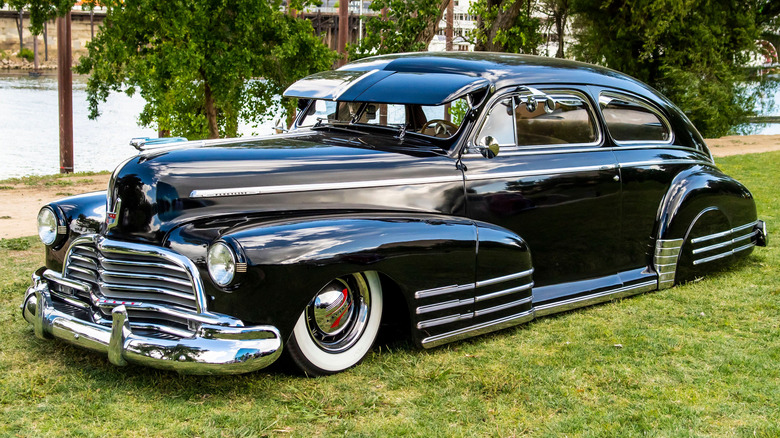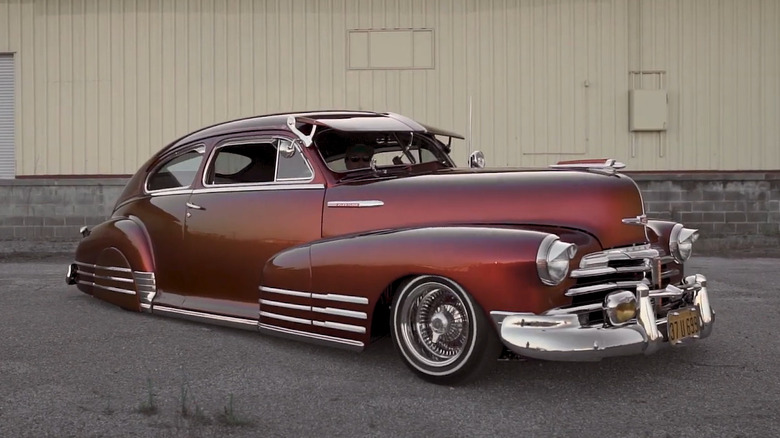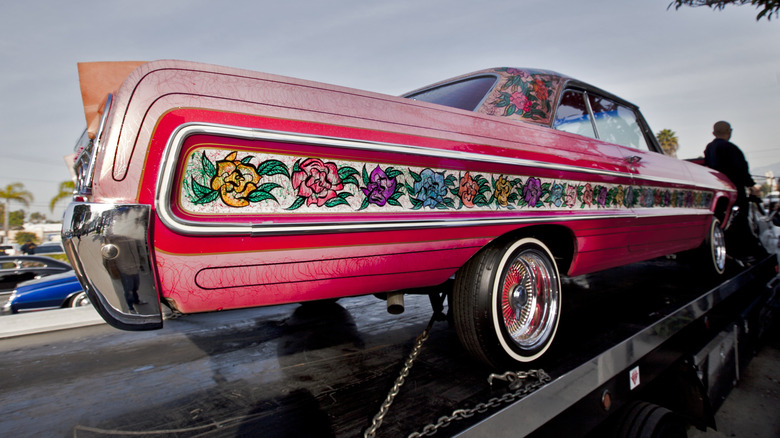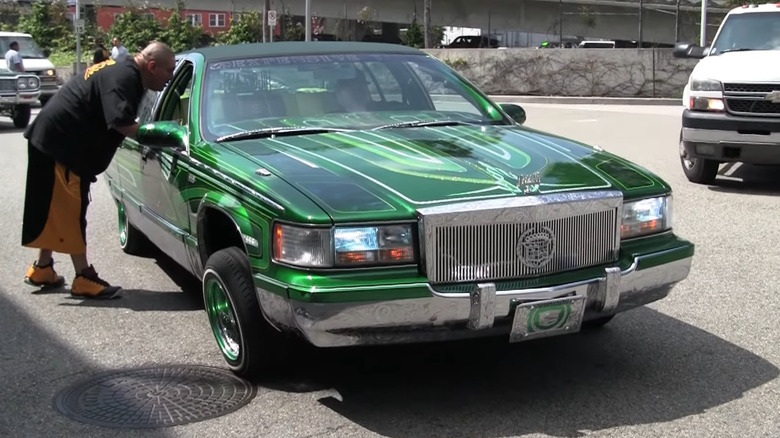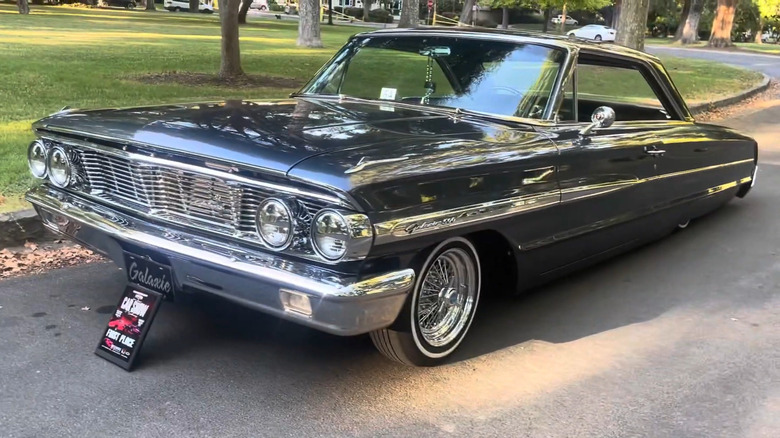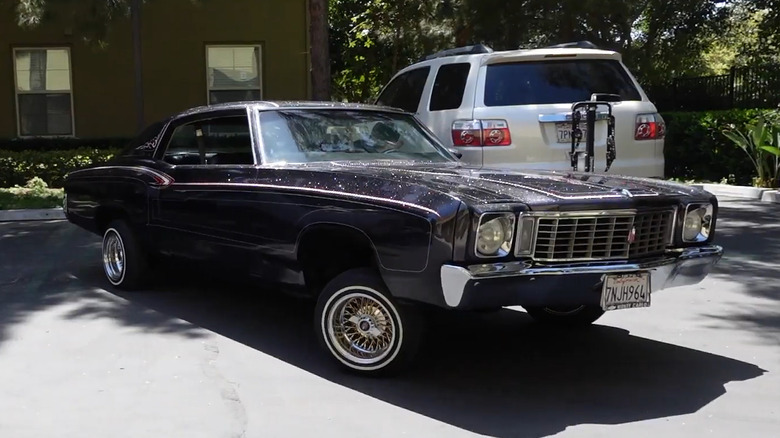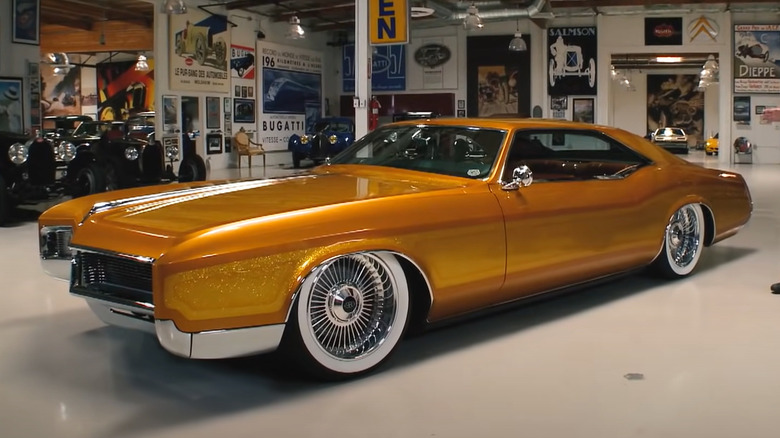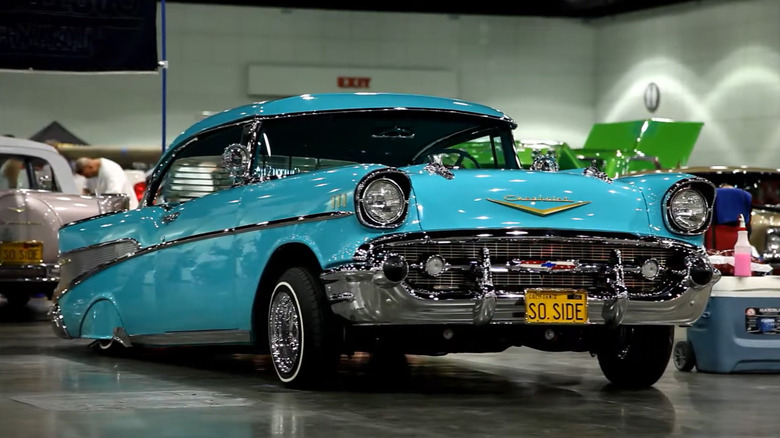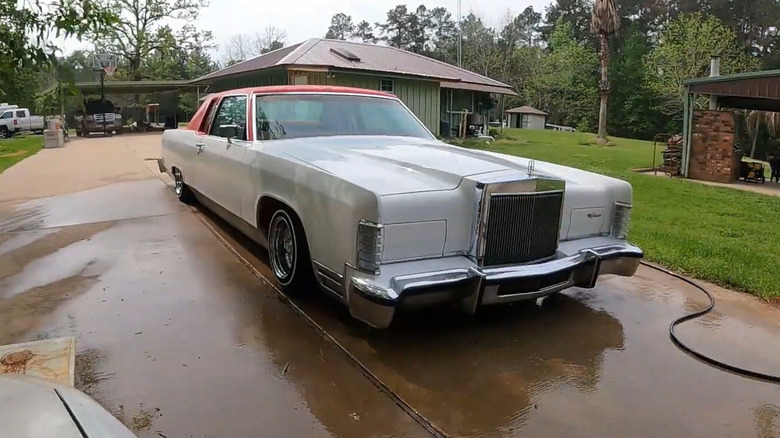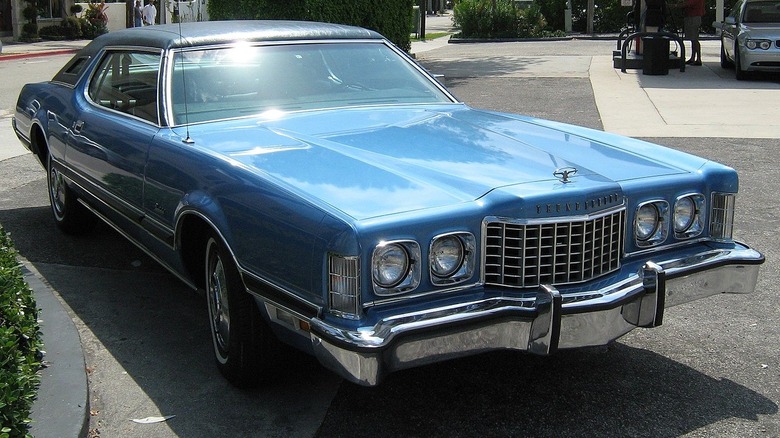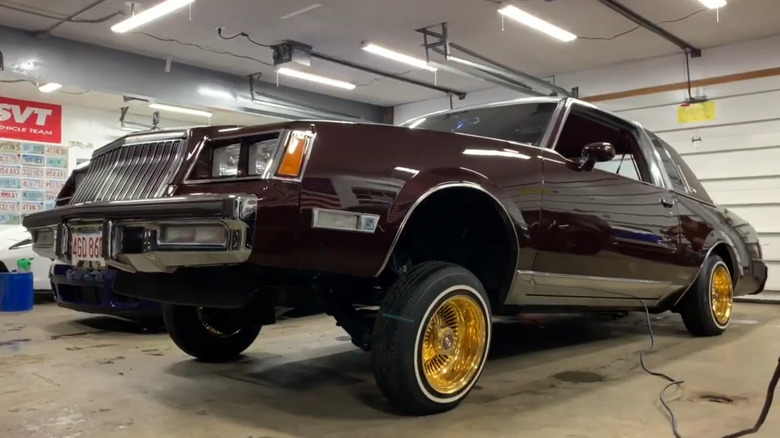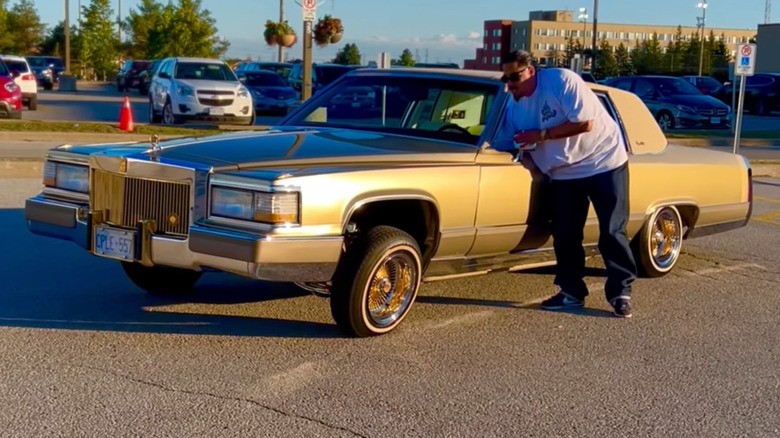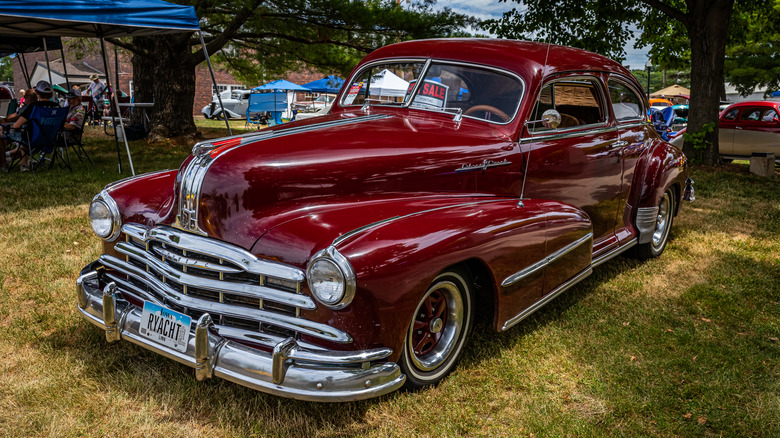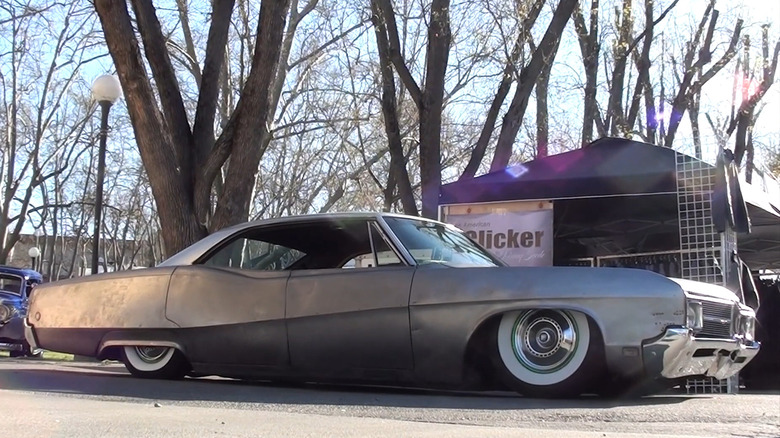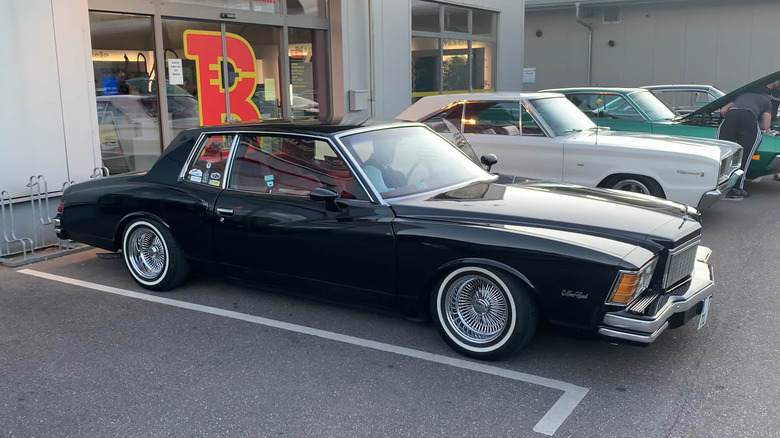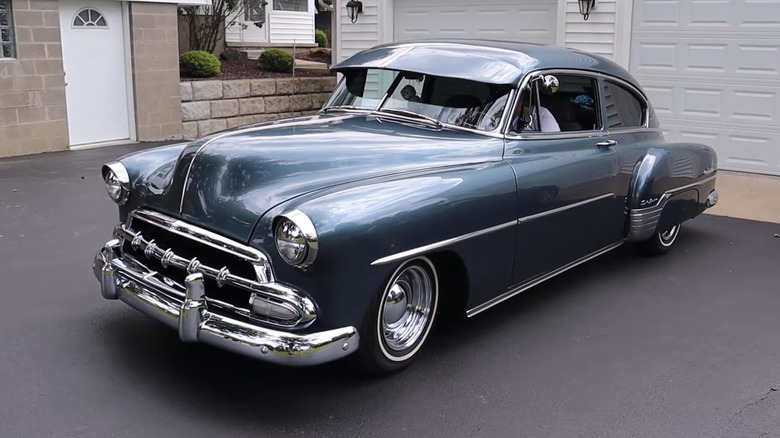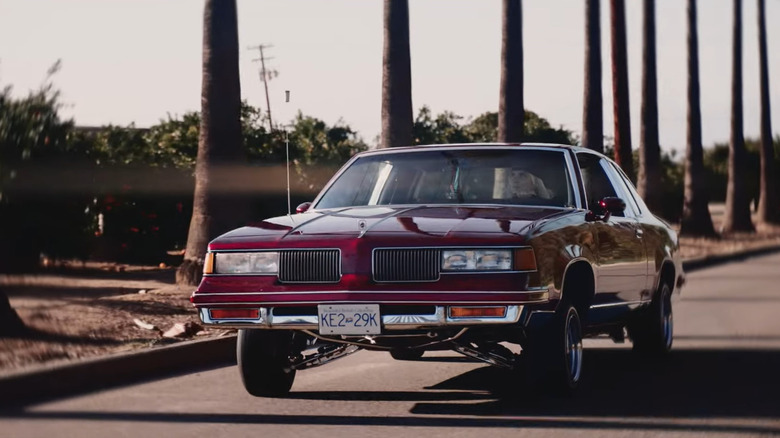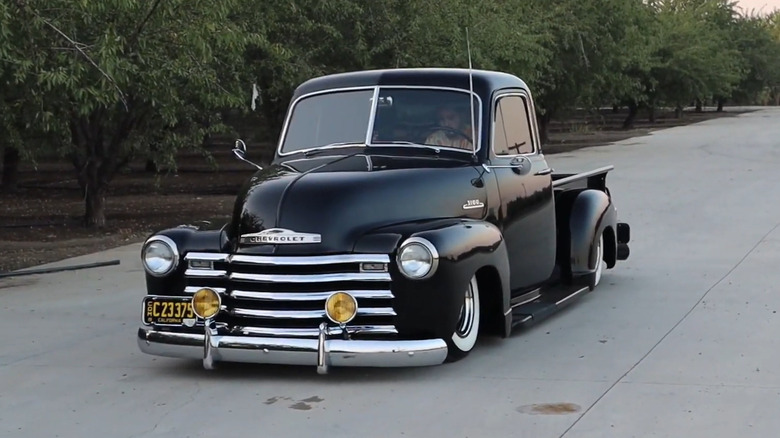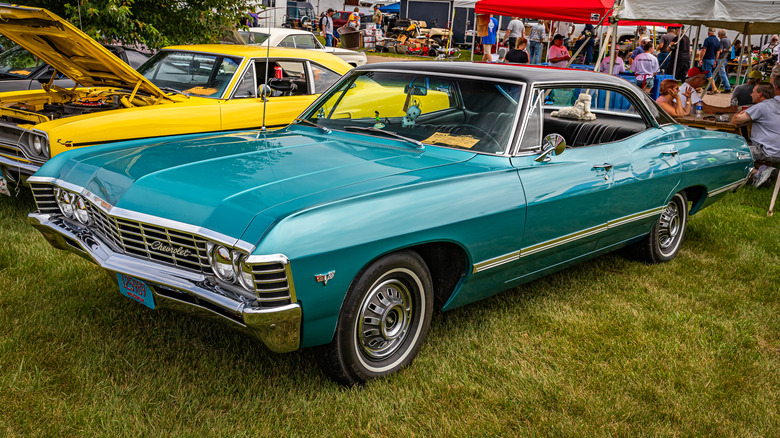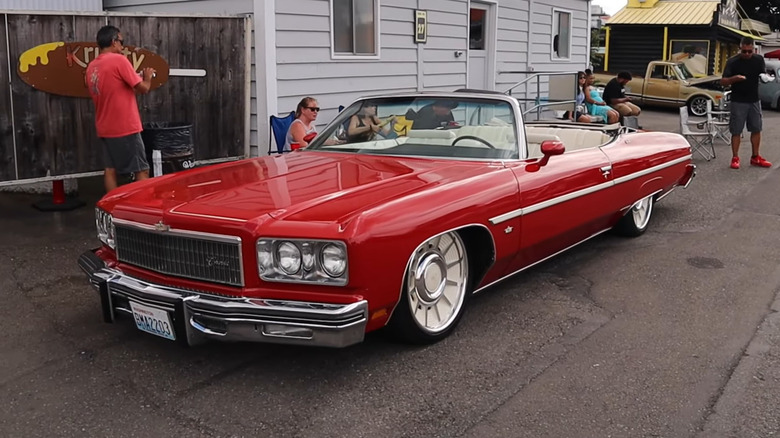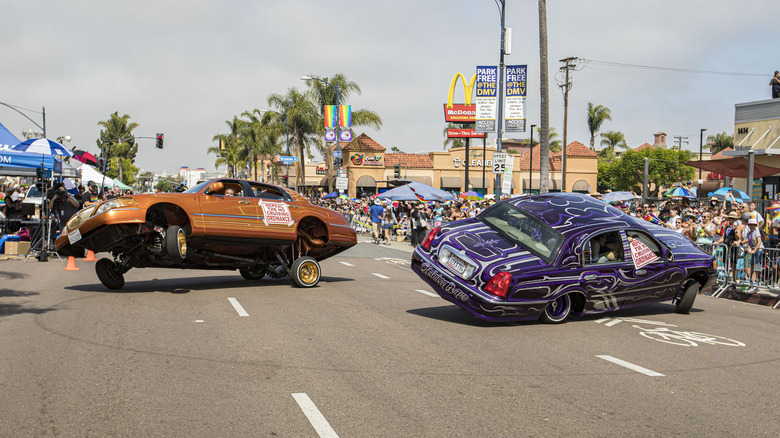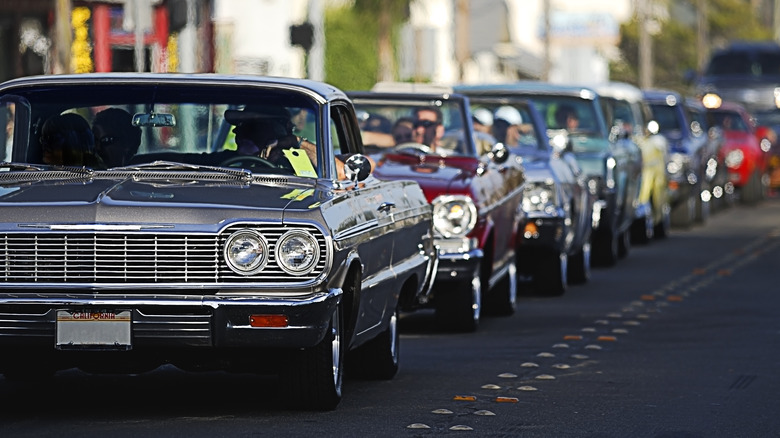20 Cars That Make Awesome Lowriders
Any enthusiast will be well aware that cars can be much more than simply a mode of transport. New York's MoMA held its first exhibition of automobiles in 1951, showcasing eight models that the museum's curators thought best displayed the relationship between America's rapidly evolving car culture and the art world. The exhibition focused on unmodified cars, but in doing so, it overlooked two key movements emerging on the other side of the country at the time: hot rods and lowriders. Devotees of the former focused on making their cars faster and more powerful, whereas the latter was all about forging an identity and making a statement.
Lowrider culture emerged in Los Angeles in the late '40s, with Mexican Americans buying and then modifying cars using money they'd earned during the Second World War. Unlike hot rodders, who focused on power, lowriders preferred to cruise "low and slow," with most modifications being centered around visual appeal rather than performance. Over the decades, these cars became increasingly elaborate, with vibrant paintwork, intricate murals, and hydraulic suspension.
Automobiles that started off as simple family haulers became rolling artworks, and fittingly, some of the most famous examples have since been shown in institutions like the Petersen Museum. Most, however, remain in the hands of those who made them or passed down through families. Many American classics can be made into lowriders, but these models stand out as top choices for anyone looking to build their own.
Chevrolet Fleetmaster '48
The Chevy Fleetmaster was produced for only a few years between 1946 and 1948 but proved popular throughout its short lifespan. Designed as an affordable, readily available model to cater to American veterans returning after World War II, more than 200,000 examples were sold during its final production year. Cars like the Fleetmaster became the first lowriders, as Mexican Americans used their mechanical skill — some of which had been gleaned from wartime service — to create cars unique to their community.
In modern lowrider culture, these early cars are referred to as "bombs." Most bombs kept their stock engines, which in the '48 Fleetmaster's case was a standard 216 cubic inch straight-six. It produced 90 horsepower from the factory and was mated to a three-speed automatic transmission. Other bombs, including some contemporary '48 Fleetmaster builds, feature a 235 cubic inch engine. Despite being more than three-quarters of a century old, the Fleetmaster's place as one of the originating models of lowrider culture ensures that there are still plenty of examples around today.
Chevrolet Impala '64
Lowriding continued to grow in popularity in the immediate decades after the war, hitting what many consider to be its golden era in the '60s and '70s. Several models grew to be particularly notable during the era, arguably none more so than the '64 Impala. Many high-profile '64 Impala builds exist, but one in particular stands out from the rest. The Gypsy Rose is a '64 Impala built by Jesse Valadez, most well known for its appearance in the opening scenes of the 1974 sitcom "Chico and the Man." The famous Gypsy Rose is the third car to bear the name — Valadez built two prior Impala lowriders, a '60 and a '63, with the '63 being the first to bear the distinctive rose design.
Unfortunately, that car was destroyed in a gang-related incident, prompting Valadez to build a new Impala even more extravagant than before. It featured 115 roses, along with leaves, cobwebs, and pinstriping, with each detail hand-painted by Walt Prey. The car is still under the Valadez family's ownership today, but in recent years it's been exhibited in the Petersen Museum and even shown at events in Japan.
The Gypsy Rose might be the most famous Impala lowrider, but it's far from the only reason that the '64 Impala is so sought-after. The "6-4's" appearances in TV shows, music videos, and other media have ensured that it's an icon even for those with only minimal knowledge of lowrider history.
Cadillac Fleetwood '94
Many people most closely associate lowriding with cars from the '60s and '70s, but it's common to see big-body American cars from the '90s given the lowrider treatment too. Among the most popular is the Cadillac Fleetwood, which has all the ingredients for a perfect lowrider. Its expansive bodywork leaves plenty of room for custom murals to be painted, and its LT1 V8 engine lends itself well to slow boulevard cruising. While the oldest lowriders — bombs like the Fleetmaster — don't always feature hydraulic suspensions, more modern cars like the Fleetwood will nearly always feature a hydraulic or airbag setup.
The Fleetwood was one of the last cars to use GM's D-Body platform, which was already thoroughly outdated by the time the second generation car was unveiled in 1993. Rival cars boasted better handling, better economy, and modernized technology, but the Cadillac had something else that the others couldn't match: retro charm. It was, underneath, essentially the same car that GM had been building for decades, but that made it easy to work on and perfect for lowrider cruising.
Ford Galaxie '64
While many of the most popular cars for lowriding are GM products, the Blue Oval is also well-represented in the community. Much like the '64 Impala, the low, classic lines of the '64 Galaxie make it a top candidate for lowrider conversion. Its stock engine makes it, again like many classic lowriders, slow by default. However, not all owners are so keen to leave it that way. One lowrider Galaxie that appeared at the SEMA show in 2017 featured a 482 cubic inch twin-turbo big block V8 under the hood, churning out 1,100 horsepower.
It sat just as low as any other lowrider, which helped hide the wide rear tires that ensured the Galaxie's engine could transfer all that power to the ground. Its rims were considerably larger than the usual 13-inch sets that lowriders prefer, presumably a necessity to fit the high-performance tires. Some might argue that, given its stripped-back appearance and high power output, this Galaxie wasn't a lowrider at all, but rather a hot rod. After all, the line between the two can sometimes be blurry. Whatever you want to call it, it's mighty impressive.
Chevrolet Monte Carlo '72
Although it's not as sought-after by most classic car collectors as the related Chevelle, the first-gen Monte Carlo remains a popular choice for lowrider builders. Pristine examples of the Monte Carlo SS 454 remain out of reach for all but the most well-heeled builders, but lower-spec examples in less clean condition can be picked up for much more attractive prices. They will, of course, require significantly more cosmetic restoration, but that's par for the course for a lowrider build anyway.
The Monte Carlo was a popular car when it launched in 1970, significantly outselling its biggest rival from the Blue Oval, the Thunderbird. It featured either a 350- or 400-cubic-inch engine, with a variety of transmission options available, both automatic and manual. With the larger, more powerful V8, the Monte Carlo became more of a muscle car than a cruiser — although never quite to the same extent as the Chevelle. The Monte Carlo's middle-ground status might have limited its appeal with classic car collectors, but in lowrider form, it's anything but middling.
Buick Riviera '66
Like many great American cars from its era, the '66 Buick Riviera looks great straight from the factory. However, some would argue that almost any car's looks can be improved with the right modifications. Certainly, owners of Riviera lowriders would agree — unique paint, lower suspension, and all the usual flashy extras help differentiate their ride from the rest. The Riviera was first introduced in 1963 and aimed to incorporate European design elements while keeping a distinctly American overall shape.
A minor facelift was introduced for the 1965 model year, with a more thorough overhaul implemented in '66. A new, stretched hood was said to be one of the longest on the market at the time, but for lowrider builders today, that only means one thing: more room for intricate designs. Just over 45,000 examples of the Riviera were sold for the '66 model year, making it significantly rarer than many other lowrider favorites — for context, Chevy sold over 1 million examples of the Impala in '65.
Chevrolet Bel Air '57
Another all-American icon, the '57 Bel Air was the last model year before the Impala was introduced. It was extremely popular, with over 700,000 examples produced and a range of seven different variants available. Hardtops were then the most popular variant, but convertibles became a particularly common option for lowrider conversion in the decades after. Not every example looks as distinctive at first glance — with such an iconic car, some builders preferred to keep their modifications more subtle, hiding them away under the hood or in the trunk.
Engine bay modifications are a key part of the lowrider look, from chromed engines to murals on the underside of the hood. While many owners prefer to keep their engines mostly original, a few prefer to break the mold. Some have even debuted Bel Airs with modern LS engines, pushing their power output up to significantly higher than stock, all while keeping the traditional skinny wire wheels faithful to the lowrider look. Choosing to LS swap a lowrider might not be conventional, but there are more benefits than might first meet the eye. LS engines bring better reliability, a huge aftermarket, and more horses to play with. Perhaps most importantly, they still look cool when the hood's lifted too.
Lincoln Continental Mark V '79
Long, luxurious, and powered by a smooth V8 engine, the Lincoln Continental ticks all the right boxes for a lowrider. Mark V Continentals have been found at lowrider meets for decades, and have remained popular with a new generation of builders looking to emulate the cars they saw as children. The elongated hood and trunk make them a particularly striking sight with their hydraulics lifted — it doesn't take much for the back end of the car to scrape the floor while the front is several feet in the air.
Systems like this were originally born out of necessity for the lowrider community, but they've evolved over the years to become a symbol of the culture. The introduction of hydraulics can be traced back to a 1958 California law that banned cars from having any part of the body ride lower to the ground than the bottom of the wheel rims.
That made lowriders illegal to drive on the road, and so owners fitted hydraulic suspensions that could quickly revert to stock height when cops drove by. From there, the culture of "hoppers" evolved, with owners chasing ever more impressive ways of hitting switches. The Continental isn't usually found in hopping contests — at least, not classics like the '79 –]– but later '90s models have been successfully used for hopper builds. Instead, most '79 owners are content doing what owners of the stock Continental have always done: cruise the streets in style.
Ford Thunderbird '73
The Thunderbird was originally conceived, per its maker, as a "true Ford sports car." However, by the time the '73 Thunderbird was unveiled it had become more luxurious than sporty. The idea of "personal luxury" was very much in vogue, and the '73 redesign proved to be the most commercially successful yet, with over 87,000 examples sold that year. A standard 385-cubic-inch V8 provided the car with ample grunt for cruising, while the 460-cubic-inch V8 from the Lincoln Continental was optional.
The original '55 Thunderbird might have been far from the ideal platform for a lowrider, but the '73 fitted the bill perfectly. It's been the base for several notable projects, including the "Star Car," which became one of the first lowriders to be exhibited at the Petersen Museum in 2000. The car featured over 150 pictures of the King of Pop, Michael Jackson, on its bodywork, giving it its name.
[Featured image by CZmarlin via Wikimedia Commons | Cropped and scaled | Public Domain]
Buick Regal '86
The '86 Buick Regal could become several different beasts depending on how it was optioned. At the most affordable end, the base-spec Regal was comfortable and luxurious, but its 110-horsepower V6 engine wasn't going to win any awards for performance. In the middle of the range sat a 307-cubic-inch V8 with a more respectable 140 horsepower. Then, at the top of the range sat the Turbo Regal, with a boosted V6 churning out 235 horsepower. It was crowned by journalists of the era as America's fastest car, beating anything on offer from Chevy or Ford.
A tire-shredding muscle car might not seem like the ideal platform for a lowrider, but builds have appeared over the years sporting the turbo engine. Others prefer to use the mid-spec, Oldsmobile-built V8. Aside from its powertrain, the Regal ticks all the other key boxes for lowrider readiness: an old-school look, a plush interior, and plenty of room in the trunk for those all-important hydraulic systems.
Cadillac Coupe DeVille '84
The Cadillac Coupe DeVille is another long-standing favorite among lowrider owners, with the '84 model year being the last of the fifth-generation car. Changing consumer tastes saw the fifth generation, first introduced in 1977, downsized compared to the previous Coupe DeVille. While it retains a fanbase, the early '80s Caddy has never reached the same collectible status as golden-era Cadillac models, and that helped keep prices within the reach of buyers looking for an affordable project car.
Its V8 engine is also smooth enough that it's perfect for cruising low and slow from the factory. Many lowrider builds leave it unchanged, opting only to chrome plate it for maximum visual impact. A less glamorous but equally important benefit the '84 Coupe DeVille's engine boasts is its parts availability. It makes the V8 accessible and affordable to work on, which in turn means that owners can spend less time worrying about things like emissions regulations, and more time focusing on their car's appearance. The car's popularity as a lowrider has seen it recreated in other mediums, with diecast maker Revell launching a 1:64 scale collectible model of an '84 Coupe DeVille lowrider in 2003.
Pontiac Torpedo '48
While Chevys are the most common bombs, models like the Pontiac Torpedo also make similarly good starting points for a project. The Torpedo was first launched in 1939 and continued to be produced until 1948, although production was halted during the Second World War. The '47 and '48 model years are the most popular models to find in running condition today, simply by virtue of the large number of examples produced for each model year. Although, earlier examples make just as good a platform for a lowrider project.
The stock or straight-6 straight-8 engines are not the easiest to find parts for, and they're slow even by low-rider standards. As a result, many owners opt to swap in more modern Pontiac or Chevy V8 engines instead. The engine bay is large enough to fit a wide range of GM V8 engines, so exactly what an owner opts for will come down to budget, personal preference, and how much they're aiming to boost their car's performance.
Buick LeSabre '68
Lowrider owners who want a car that's much like an Impala — a classic design, scope for modifications, and an old-school GM engine — but don't want an Impala have plenty of other options. Among the best is the Buick LeSabre, which offers all of the above plus the bonus of being much rarer than its Chevy equivalents. The generously sized engine bay makes it a great choice for an LS swap, which not only boosts the car's power output but can improve reliability.
Breaking down is an almost inevitable part of cruising any old car, but fitting a modern engine and transmission significantly cuts an owner's chances of being stranded at the side of the road. The Buick's versatility makes it appealing for owners all over the country — while lowrider culture is most closely associated with West Coast hotspots like Whittier Boulevard, Le Sabre lowrider builds can be found at meets from California to Indiana.
Chevrolet Monte Carlo '79
The third-generation Monte Carlo was smaller and lighter than its predecessor, following GM's lineup-wide revision of its models. It debuted in '78 and was produced for only three model years in total. Changes between model years were only minimal, with all years receiving a 20-cubic-inch V6 as a base option. Buyers with more to spend could upgrade to either a gas or diesel V8. None of the third-generation Monte Carlo's engine options were particularly fast, even compared to earlier iterations of the car. But, that wasn't much of a problem for buyers looking to cruise low and slow.
Nonetheless, some '79 Monte Carlo lowriders today feature engine modifications or performance upgrades, especially those with the base V6 under the hood. While most owners would argue that a lowrider can never be too low, it seems that being too slow is still a sticking point for some enthusiasts.
Chevrolet Fleetline Deluxe '52
The Fleetline Deluxe emerged during a transition period in Chevy's history. Produced a few years after the original post-war peak of the late '40s, when the automaker was churning out hundreds of thousands of Fleetmasters, the '52 Fleetline was a lot less appealing to buyers. It was neither the most fresh-looking nor the most technologically advanced car of its day, and Chevy was still half a decade or so away from unveiling cars like the iconic '57 Bel Air.
However, a '52 Fleetline Deluxe makes a great project for several reasons. Despite the car's age, parts are still relatively easy to source, and the old-school 216 or 235 engine is easy enough to work on. In lowrider terms, the car is considered a bomb, and its relatively under-the-radar status has made it a top choice for owners looking for old-school cool without breaking the bank. Like any other lowrider bomb, most owners prefer to retain either a 216 or 235 engine, both for its easily repairable nature and unique soundtrack.
Oldsmobile Cutlass '87
Throughout the late '70s and early '80s, few other cars could match the commercial success of the Oldsmobile Cutlass. It topped the sales charts every year from 1978 through 1981, then again in 1983. By the late '80s, however, its star had begun to fade. Americans began favoring smaller, more nimble cars, with the Ford Escort taking the sales crown in 1987. Despite losing its appeal to buyers at the time, the '87 Cutlass has enjoyed better longevity among enthusiasts than the Escort, in part due to its appeal as an affordable base for modified car projects. It's not uncommon to find '87 Cutlass Supremes converted into drag cars, but they can also frequently be spotted at lowrider meets.
The engines underneath each build vary considerably — some '87 Cutlasses left the factory with a six-cylinder that was borrowed from Buick's lineup, some featured Oldsmobile's 307 cubic inch V8, and other builds choose to rip out the original engine altogether for something more modern and powerful.
What remains across nearly all great Cutlass lowriders, however, is the intricacy of the exterior and interior design. Despite downsizing from the previous generation car, the '87 Cutlass still packs plenty of sheet metal real estate for mural artists and pinstripers to work their magic. That ensures that each lowrider is far removed from the stock Cutlass' run-of-the-mill roots.
Chevrolet 3100 '53
Although it's cars that are most often the stars of the show, they're far from the only modes of transport to have gotten the lowrider treatment over the years. Lowrider bicycles are a popular entry level option into the movement, and lowrider motorcycles also form an important part of the culture. It should be no surprise either that, given America's insatiable love of pickups, there have been plenty of excellent lowrider truck builds over the decades too. One of the most popular truck models to modify is the Chevy 3100, in particular, the '53 model year.
Like most Chevys of its era, a 235 or 216 engine is most commonly found under the hood, albeit often with some performance parts to give owners some extra horses to play with. The truck was available with a huge range of options when new, and sourcing these period-correct extras is a key way for lowrider owners to add a personal, more subtle touch to their build. Often, these builds tend to eschew neon paintwork or large murals, instead choosing more understated paint schemes that highlight and accentuate the original lines of the truck.
Chevrolet Impala '67
Although it's the '64 Impala that remains the most iconic for many enthusiasts, the '67 Impala is pretty close behind. The fourth generation Impala first launched for the '65 model year and continued to see iterative improvements through '67, helping to catapult the car to new sales highs in the process. This popularity has ensured that plenty of examples continue to be available nearly 60 years later in a wide range of conditions.
That last part is particularly key to the Impala's appeal: those with the budget can source a clean example and load it up with expensive parts and accessories, but others with less cash to spend can still restore a rusted-out example without breaking the bank. The end result, when done properly, will still look just as eye-catching either way. The clean lines of the '67 Impala mean that there's no need to go too crazy with the paint designs either — although that doesn't stop some owners from layering on the candy paint.
Chevrolet Caprice '75
The '75 Caprice isn't the most recognizable model year to bear the nameplate. Later Caprices sold better and found fame as cops cars both on the street and on the big screen, while the '75 Caprice, then only in its second generation, was neither the freshest nor the most distinctive design on the market. Over the decades, however, plenty of '75 Caprices have been given a much more eye-catching look as fully rebuilt lowriders.
In some cases, the most dedicated owners have built several examples one after the other, drawing on their expertise from previous builds to develop new ideas and source parts from a diverse array of other cars. While the top-spec Caprice's V8 engine provides more than enough power in stock form, other components like the brakes and exhaust are ripe for upgrading, assuming owners have the budget to do so. They'll need a healthier budget than some of the other cars here too, as Caprices in good condition command a premium on the used market, even if values have remained largely flat for a few years now.
Lincoln Town Car '98
While cars from the '50s, '60s, and '70s formed the backbone of the lowrider community for decades, continuing the tradition for the modern era inevitably means incorporating more recent models into the fold. One model that's risen in popularity in recent years is the third-generation Lincoln Town Car, which debuted for the 1998 model year and remained in production until 2011. A big, heavy, luxurious sedan, the third-gen Town Car shares many of the key elements that make big body classics so appealing, but it doesn't come with any of the common problems that most 50- to 60-year-old cars will inevitably bring.
It's also affordable to buy used, and should continue to be for the foreseeable future since there are so many examples still on the road. Lowriders built out of modern cars always draw attention — take, for example, the Tesla Model Y on wire wheels that appeared at SEMA 2023. Unlike the Tesla, however, a Town Car still boasts that old-school V8 charm that will win over purists and pioneers alike.
Our selection methodology
There is a huge range of classic American cars that make great lowriders, and so to whittle down our selection into these top picks, we focused on several key criteria. The first was to establish models (and model years) with particularly notable builds, zeroing in on those that stood out from the rest as being especially famous both to lowrider enthusiasts and to those outside the community.
We also considered long-term popularity, evaluating whether a particular car gained a reputation for being easy to turn into a great lowrider. Finally, we scoured magazine archives and video shoots to make sure that each model produced consistently cool lowriders — after all, the most important factor has to be just how awesome the final car looks. We aimed to include as broad a range of models as possible, showcasing not just the golden era icons but also other influential models, both older and newer, that have been built by lowrider enthusiasts across the country.
